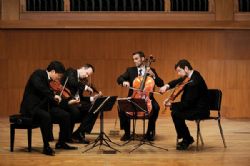|
Symphony
SRS SEASON ENDS WITH RESOUNDING TA-TA-TA-BANG
by Terry McNeill
Sunday, June 1, 2025
Symphony
YOUTHFUL VIRTUOSITY ON DISPLAY AT USO'S MAY CONCERTS
by Peter Lert
Saturday, May 17, 2025
Symphony
MYSTICAL PLANETS AND LIVELY GERSHWIN ORTIZ AT FINAL SRS CONCERT
by Peter Lert
Sunday, May 4, 2025
Symphony
VSO'S CONCERT MUSIC OF TIME, MUSIC OF PLACE
by Peter Lert
Sunday, April 27, 2025
Choral and Vocal
VOCAL ELEGANCE AND FIRE AT THE 222'S RECITAL APRIL 26
by Pamela Hicks Gailey
Saturday, April 26, 2025
CANTIAMO SONOMA SINGS AN INSPIRED GOOD FRIDAY MOZART REQUIEM CONCERT
by Pamela Hicks Gailey
Friday, April 18, 2025
DRAMATIC SHOSTAKOVICH SYMPHONY CLOSES PHILHARMONIC'S 25TH SEASON
by Terry McNeill
Sunday, April 13, 2025
LARGE COLLEGE OF MARIN AUDIENCE GREETS STOPHER ARTISTRY
by Terry McNeill
Saturday, April 5, 2025
Chamber
FRISSON DELIVERS SHIVERS OF DELIGHT
by Abby Wasserman
Sunday, March 30, 2025
OLD AND MOSTLY NEW IN SRS MARCH CONCERT IN WEILL
by Peter Lert
Saturday, March 22, 2025
|
 |
 Miró Quartet |
PENULTIMATE CHAMBERFEST CONCERT HAS LYRICAL POWER
by Sonia Morse Tubridy and Nicki Bell
Saturday, June 25, 2016
Program six June 25 of the summer ChamberFest at Schroeder was once again a concert memorable on its own but also, for those who attended the whole series, a beautiful finale to a grand and concentrated chamber music experience. Each concert illuminated the others and created musical and emotional connections throughout.
Schubert's Arpeggione (D. 821) Sonata started the evening with music of supreme lyrical power, simple but sophisticated. Written for an instrument now extinct, tuned like a guitar but played like a cello, the Arpeggione was performed by cellist Desmond Hoebig and pianist Jon Kimura Parker. Their collaboration was sensitive and the piano accompanying passages were supportive and never overpowered Mr. Hoebig’s touching sweet melodies and playful interludes. As in many of the performances, nuances of quiet were caressing and drew the audience close to the music.The second movement was a pure and loving Lied in which to savor the sweet sound of Mr. Hoebig's playing. There was no busyness or overplaying. A flowing melodic theme initiated the third movement where Schubert, as always, composed a work overflowing with songs and dances.
The three featured Festival composers were child prodigies and took music to new levels of intimacy rather than merely showmanship. Mozart's G Minor String Quintet (K. 516) has two violas, with Paul Neubauer joining the Miró Quartet, and his playing added an extra dark ambience. Mozart's favorite instrument was said to be the viola. This Quintet is in that category of music which has a sense of being fleeting but eternal. The first movement was set in motion with the violin singing over a pulsing accompaniment, operatic with tragic minor colors. It then at times becomes orchestral and there is the same ambiguity of major and minor also experienced in Schubert's music. The Menuetto is startling in its freedom of rhythms and abrupt accents. Dark crashing chords are followed by a sweet lyric trio in major.
The playing of the Adagio was muted and mysterious and created a mood of personal expressiveness. Instruments traded thoughts and there was much string stopping and use of silence. The fourth movement is introduced by another Largo in which dissonances melt and dissolve with cello pizzicato punctuating and tentative pauses. Then comes the rollicking dance, an exuberant happy ending to this story that was played with energetic clarity.
Following the intermission eight musicians gathered on stage for the Mendelssohn’s E-Flat Major Octet, the last work of the series in Schroeder. The Miró’s first violinist Daniel Ching shared from the stage experiences of a string quartet's travels and humorous encounters, and related it was a wonderful life to travel and play this music. The Octet was written when Mendelssohn was sixteen years old, and he stretched the delights of chamber music to the edges of orchestral music.
Eight individual voices can be heard in great woven ensemble. The first movement is heroic and energetic; then the second was sad and melancholy, questioning and searching. The Scherzo is multi-layered, full of little surprises from different instruments. Birds and butterflies could flutter their wings here. The Presto finale is a "barn burner" with cellists Joshua Gindale and Hai-Ye-Ni leading the ensemble with lightning speed into a fugal extravaganza. Trumpets seem to call, huge swells pulse with currents, rising harmonies build and shimmer. This Octet is vitality itself.
The audience cheered and whistled.
|
